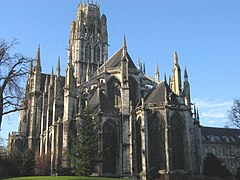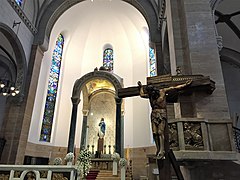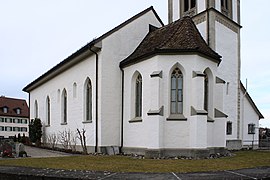Apse


Inarchitecture,anapse(pl.:apses;fromLatinabsis,'arch, vault'; fromAncient Greekἀψίς,apsis,'arch'; sometimes writtenapsis;pl.:apsides) is a semicircular recess covered with a hemisphericalvaultorsemi-dome,also known as anexedra.InByzantine,Romanesque,andGothicChristianchurch(includingcathedralandabbey)architecture,the term is applied to a semi-circular or polygonal termination of the main building at theliturgical eastend (where thealtaris), regardless of the shape of the roof, which may be flat, sloping, domed, or hemispherical. Smaller apses are found elsewhere, especially inshrines.[1]
Definition
[edit]An apse is a semicircular recess, often covered with a hemispherical vault. Commonly, the apse of a church,cathedralorbasilicais the semicircular or polygonal termination to thechoirorsanctuary,or sometimes at the end of an aisle.
Smaller apses are sometimes built in other parts of the church, especially forreliquariesorshrinesof saints.[citation needed]
History
[edit]The domed apse became a standard part of the church plan in the early Christian era.[2]
Related features
[edit]In theEastern Orthodox Churchtradition, the south apse is known as thediaconiconand the north apse as theprothesis.Various ecclesiastical features of which the apse may form part are drawn together here.
Chancel
[edit]Thechancel(or sanctuary),directly to the eastbeyond thechoir,contains the high altar, where there is one (comparecommunion table). This area is reserved for the clergy, and was therefore formerly called the "presbytery", fromGreekpresbuteros,"elder",[citation needed]or in older and Catholic usage "priest".[3]
Chevet-apse chapels
[edit]Semi-circular choirs, first developed in the East, which came into use in France in 470.[4]By the onset of the 13th century, they had been augmented with radiatingapse chapelsoutside the choir aisle, the entire structure of apse, choir and radiating chapels coming to be known as thechevet(French, "headpiece" ).[5]
Gallery
[edit]-
Triple apse ofBasilica di Santa Giulia,northern Italy
-
East end of theabbey church of Saint-Ouen,showing thechevet,Rouen,Seine-Maritime,France
-
A chevet apse vault, Toulouse, France
-
Apsed chancel of St Mary's Church,West Dean, Wiltshire,England
-
The decorated apse of theCathedral of Monreale,Sicily
-
The apse ofManila Cathedral,Philippines
See also
[edit]- Ambulatory
- Architectural development of the eastern end of cathedrals in England and France
- Byzantine architecture
- Cathedral architecture
- Church architecture
- Narthex
- Niche
- Scarsella
References
[edit]- ^"Basilica of the National Shrine of the Immaculate Conception: Floor Plan".NationalShrine.com.Archived fromthe originalon 9 August 2017.Retrieved27 August2016.
- ^"Apse".Encyclopædia Britannica.Retrieved10 July2012.
- ^"Where in the New Testament are Priests Mentioned".Catholic Answers.Catholic Answers.Retrieved1 September2018.
- ^Moss, Henry,The Birth of the Middle Ages 395-814,Clarendon Press, 1935
- ^"Chevet",Encyclopædia Britannica
- Joseph Nechvatal,"Immersive Excess in the Apse of Lascaux", Technonoetic Arts 3, no. 3, 2005.
External links
[edit]- Spiers, Richard Phené(1911)..InChisholm, Hugh(ed.).Encyclopædia Britannica.Vol. 2 (11th ed.). Cambridge University Press. pp. 231–232.This has a detailed description of examples in the early church.







